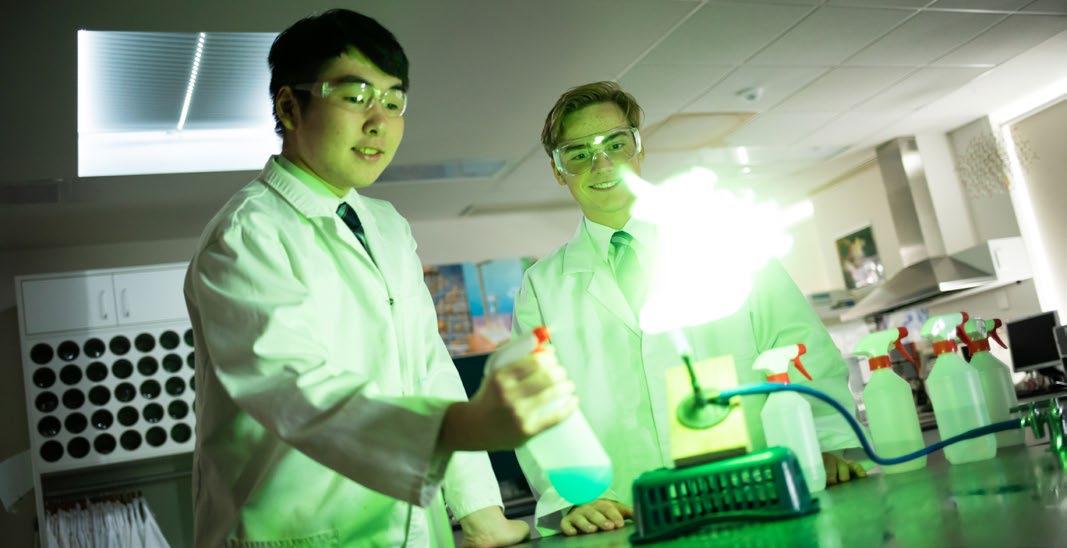
4 minute read
SCIENCE
The study of science encourages students to better understand and explain the complex world around them. Problem solving is based on concepts which are more challenging and abstract than those experienced in earlier years. Students engage in more formal thought processes and respond to greater intellectual challenges, including higher levels of mathematical procedures. They are expected to plan and conduct investigations and interpret their results.
SUBJECT STRUCTURE
Year 7
Science 7
Year 8
Science 8
Year 9
Science 9
INFORMATION TECHNOLOGY
Notebook computers are used extensively in Science as a research tool to investigate the applications of Science in the real world. The use of simulation software complements practical activities. Students use the Microsoft Office package to draft and present reports and assignments. Classes use the online Schoology learning management system to submit assignments. Year 9 Science The Scientific Approach: This unit discusses the nature of Science, the relationship between science and technology, experiment design and reporting, measurement errors, significant figures, logical thinking, creativity and problem solving. Students conduct practical experiments requiring effective experimental design and undertake a major individual research project. The concepts are reinforced with STELR investigations into wind turbines and solar panels. Ecosystems: This unit explores the complexity of life and the varied interactions of living things within their environment. Students study energy transfer and cycling of matter through the Earth’s biosphere, the connection between biotic and abiotic factors, the pressure of human population growth and the growing awareness of the interdependency of all organisms. Body Systems: Multicellular Organisms are clusters of specialised cells that perform distinct roles. All organisms receive a myriad of changing internal and external stimuli, the rapid reaction to which ensures their survival. Students will investigate the importance of homeostasis and the roles of the nervous and hormonal systems to maintain this delicate balance.
Year 10
Science 10
Year 11
Chemistry 1 & 2
Physics 1 &2
Biology 1 & 2
Year 12
Chemistry 3 & 4
Physics 3 & 4
Biology 3 & 4 Biology 3 & 4
ASSESSMENT
Science is assessed using a range of activities, including practical reports, research investigations, homework, class activities and tests. Students are assessed on their knowledge and application of Scientific concepts complemented by production of reports and
homework assignments. Light, Sound and Radioactivity: Students study the properties of light and the electromagnetic spectrum, refraction, reflection and colour mixing. Applications of this technology include the eye, spectacles, camera, microscope and projectors. They also study the processes of radioactivity and its effects on human populations.
Chemistry: A range of chemical reactions is observed as students study the chemical and physical properties of the first 20 elements. Students see the links and trends within the periodic table and predict possible reactions. By learning chemical language, they can write chemical formulas and balance equations.
Astronomy: This unit looks at the position of stars and deep space objects in the night sky, the positional changes over a day or year and the use of major constellations in the Southern Sky for direction finding. The Starry Night software is used to assist in the location and movement of space objects. Students learn of the evidence for the Big Bang theory of cosmology.
Plate Tectonics: This unit uses Plate Tectonics theory to discuss major geological building processes on earth: volcanoes and earthquakes. Students investigate seismic waves and discover how to locate an earthquake epicenter and its Richter rating from seismic data.
Year 10 Science
Students study the following topics:
Electronics: This is a practical unit involving the building of simple electronics projects using basic components such as transistors, capacitors, diodes and resistors.
Minerals to Metals: Students perform practical work to establish the reactivity series of metals. This is used to predict chemical reactions involving common metals with water, acids, oxygen and salt solutions. The physical properties and economic considerations are discussed when choosing a metal for a particular application. Students develop an awareness of the procedures employed in mining, refining and recycling of metals. A practical investigation involves the extraction of copper from malachite mineral.
Traffic: Students work in practical groups to investigate what happens in collisions. Through experiments with carts, air tables and ticker timers, they learn the principles of motion. They study Newton’s laws of motion and develop an understanding of describing motion in graphical form. Water Analysis: The physical and chemical properties of water are discussed to increase awareness of its importance in our lives. Students study common reaction tests to identify ions in solution, learn common reactions involving acids and bases. Students compare Melbourne’s water supply to other capital cities, and consider methods employed in the home to reduce water demand. A day excursion investigating the pollution a waterway looks at the effects of a city on an aquatic system.
Genetics/Evolution: All species transfer genes to their offspring. Remarkably, genes are made from only four base chemical letters; A,T,C and G. The arrangement of these letters have a profound impact on the appearance and biochemistry of all Life. Students come to appreciate how these four letters, or nucleotides, can have beneficial and detrimental outcomes on an individual’s survival, reproduction and the evolution of an entire species.
Immunology: The immune system is a fortress containing multiple defence mechanisms. Assisted by antiseptic techniques and antibiotics, the human body defies the onslaught of disease causing organisms and maintains life. Students study the constant bombardment of pathogens from our food, air, water, touch and bodily fluid. Practicals demonstrate the ubiquitous nature of bacteria and the effectiveness of different antibiotics and commercial antiseptics. Students examine diseases that have had a major impact on human history and the importance of immunisations.
FOR FURTHER INFORMATION PLEASE CONTACT
Mr Gordon Wilson
Head of Physical Science Ph: 9835 1777 Email: gw@cgs.vic.edu.au







